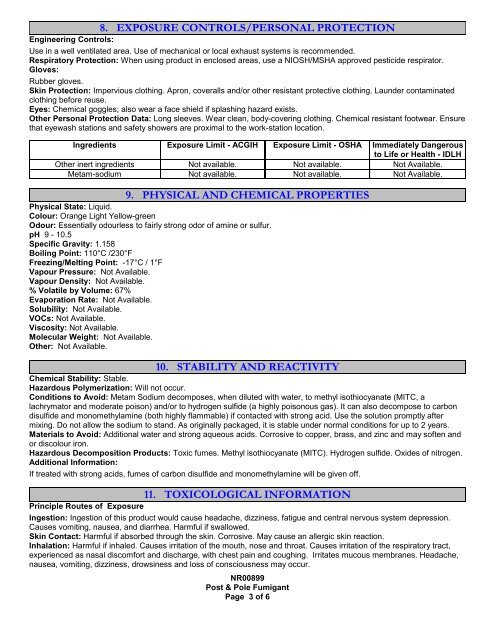Wood Preservatives Labels - BC Hydro
Wood Preservatives Labels - BC Hydro
Wood Preservatives Labels - BC Hydro
You also want an ePaper? Increase the reach of your titles
YUMPU automatically turns print PDFs into web optimized ePapers that Google loves.
8. EXPOSURE CONTROLS/PERSONAL PROTECTION<br />
Engineering Controls:<br />
Use in a well ventilated area. Use of mechanical or local exhaust systems is recommended.<br />
Respiratory Protection: When using product in enclosed areas, use a NIOSH/MSHA approved pesticide respirator.<br />
Gloves:<br />
Rubber gloves.<br />
Skin Protection: Impervious clothing. Apron, coveralls and/or other resistant protective clothing. Launder contaminated<br />
clothing before reuse.<br />
Eyes: Chemical goggles; also wear a face shield if splashing hazard exists.<br />
Other Personal Protection Data: Long sleeves. Wear clean, body-covering clothing. Chemical resistant footwear. Ensure<br />
that eyewash stations and safety showers are proximal to the work-station location.<br />
Ingredients Exposure Limit - ACGIH Exposure Limit - OSHA Immediately Dangerous<br />
to Life or Health - IDLH<br />
Other inert ingredients Not available. Not available. Not Available.<br />
Metam-sodium Not available. Not available. Not Available.<br />
9. PHYSICAL AND CHEMICAL PROPERTIES<br />
Physical State: Liquid.<br />
Colour: Orange Light Yellow-green<br />
Odour: Essentially odourless to fairly strong odor of amine or sulfur.<br />
pH 9 - 10.5<br />
Specific Gravity: 1.158<br />
Boiling Point: 110°C /230°F<br />
Freezing/Melting Point: -17°C / 1°F<br />
Vapour Pressure: Not Available.<br />
Vapour Density: Not Available.<br />
% Volatile by Volume: 67%<br />
Evaporation Rate: Not Available.<br />
Solubility: Not Available.<br />
VOCs: Not Available.<br />
Viscosity: Not Available.<br />
Molecular Weight: Not Available.<br />
Other: Not Available.<br />
10. STABILITY AND REACTIVITY<br />
Chemical Stability: Stable.<br />
Hazardous Polymerization: Will not occur.<br />
Conditions to Avoid: Metam Sodium decomposes, when diluted with water, to methyl isothiocyanate (MITC, a<br />
lachrymator and moderate poison) and/or to hydrogen sulfide (a highly poisonous gas). It can also decompose to carbon<br />
disulfide and monomethylamine (both highly flammable) if contacted with strong acid. Use the solution promptly after<br />
mixing. Do not allow the sodium to stand. As originally packaged, it is stable under normal conditions for up to 2 years.<br />
Materials to Avoid: Additional water and strong aqueous acids. Corrosive to copper, brass, and zinc and may soften and<br />
or discolour iron.<br />
Hazardous Decomposition Products: Toxic fumes. Methyl isothiocyanate (MITC). <strong>Hydro</strong>gen sulfide. Oxides of nitrogen.<br />
Additional Information:<br />
If treated with strong acids, fumes of carbon disulfide and monomethylamine will be given off.<br />
11. TOXICOLOGICAL INFORMATION<br />
Principle Routes of Exposure<br />
Ingestion: Ingestion of this product would cause headache, dizziness, fatigue and central nervous system depression.<br />
Causes vomiting, nausea, and diarrhea. Harmful if swallowed.<br />
Skin Contact: Harmful if absorbed through the skin. Corrosive. May cause an allergic skin reaction.<br />
Inhalation: Harmful if inhaled. Causes irritation of the mouth, nose and throat. Causes irritation of the respiratory tract,<br />
experienced as nasal discomfort and discharge, with chest pain and coughing. Irritates mucous membranes. Headache,<br />
nausea, vomiting, dizziness, drowsiness and loss of consciousness may occur.<br />
NR00899<br />
Post & Pole Fumigant<br />
Page 3 of 6
















